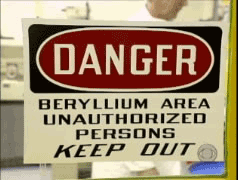
A new assessment finds that Department of Energy (DOE) is not conducting effective oversight of the Los Alamos National Laboratory (LANL) beryllium program, or of safety and health programs in general. In addition, DOE is not maintaining sufficient technical capability and knowledge of site and contractor activities to make informed decisions about hazards and risks. DOE indicated the lack of sufficient safety and health resources has presented a challenge to achieving effective oversight in this area.
The Department of Energy’s (DOE’s) Office of Enterprise Assessments recently evaluated Los Alamos National Laboratory (LANL) attempts to resolve concerns, issues, and four recommendations identified in the DOE Office of Inspector General (OIG) February 2018 report DOE-OIG-18-20, DOE Office of Inspector General’s Inspection Report of the LANL Chronic Beryllium Disease Prevention Program. This new assessment focused on the aspects of the LANL chronic beryllium disease prevention program identified in the 2018 OIG report, including beryllium inventories, hazard assessments and sampling plans, and released areas and archived records. In addition, the National Nuclear Security Administration Los Alamos Field Office (NA-LA) oversight activities associated with these areas were assessed.
In 1993 DOE officially decided to relocate beryllium manufacturing operations to LANL, which had also been performed at the Rocky Flats Plant in Colorado. DOE had previously declared that beryllium manufacturing had to be located at the future plutonium pit production facility. [Beryllium is used in plutonium pit liners, tampers, reflectors, and neutron generators for nuclear weapons.] Together, the relocation of these two missions represented a return to the lab’s historic “roots.” LANL had produced plutonium pits before Rocky Flats was built in the mid-1950’s, both for weapons that were deployed to the stockpile and for the design and testing of new weapons.
If LANL cannot clean up its beryllium act now while the Lab is not producing pits, it will have little chance of doing so under expanded pit production.
Other deficiencies
- The LANL contractor,Triad, has not ensured that the characteristics and locations of all beryllium inventory entries at the facility were documented. Approximately 20% of the beryllium inventory records reviewed by the assessment team contained inaccuracies or discrepancies with other beryllium inventory records.
- Triad has not ensured that beryllium sampling plans include the frequency, locations, and minimum number of samples to be collected.
- Triad has not ensured that beryllium areas are posted. The assessment team observed two examples of beryllium areas not posted as required. Also, the health hazard communication postings on the doors of most rooms containing beryllium are inconsistent in identifying the beryllium hazard.
Read the Report: Chronic Beryllium Disease Prevention Program Assessment at the Los Alamos National Laboratory, April, 2019
